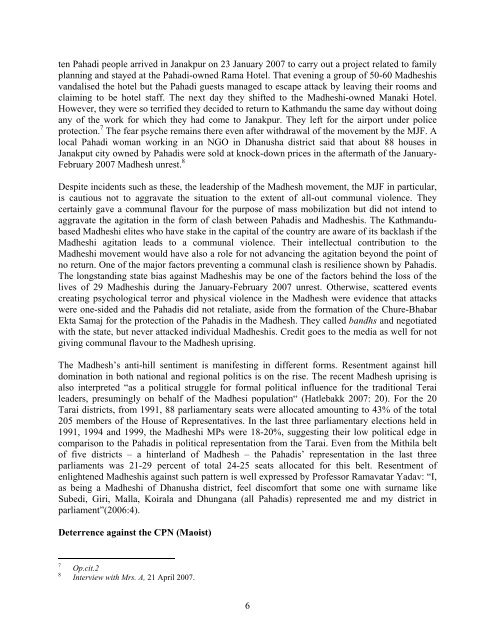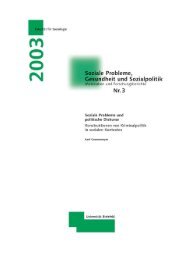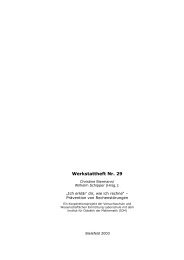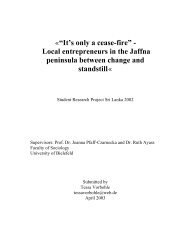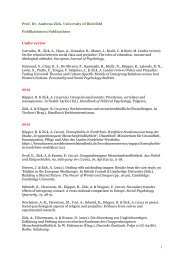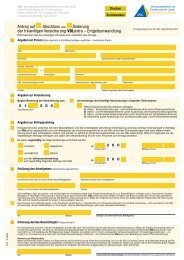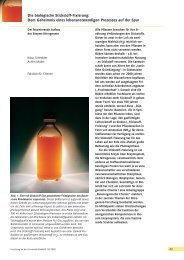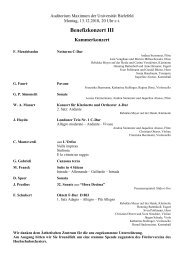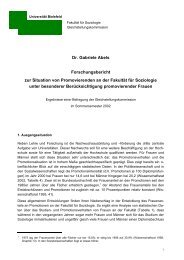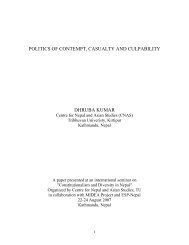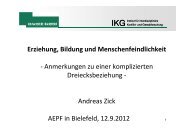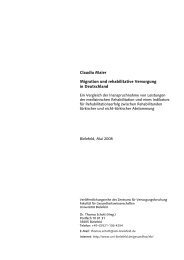Madheshi Nationalism and Restructuring the Nepali State
Madheshi Nationalism and Restructuring the Nepali State
Madheshi Nationalism and Restructuring the Nepali State
You also want an ePaper? Increase the reach of your titles
YUMPU automatically turns print PDFs into web optimized ePapers that Google loves.
ten Pahadi people arrived in Janakpur on 23 January 2007 to carry out a project related to family<br />
planning <strong>and</strong> stayed at <strong>the</strong> Pahadi-owned Rama Hotel. That evening a group of 50-60 <strong>Madheshi</strong>s<br />
v<strong>and</strong>alised <strong>the</strong> hotel but <strong>the</strong> Pahadi guests managed to escape attack by leaving <strong>the</strong>ir rooms <strong>and</strong><br />
claiming to be hotel staff. The next day <strong>the</strong>y shifted to <strong>the</strong> <strong>Madheshi</strong>-owned Manaki Hotel.<br />
However, <strong>the</strong>y were so terrified <strong>the</strong>y decided to return to Kathm<strong>and</strong>u <strong>the</strong> same day without doing<br />
any of <strong>the</strong> work for which <strong>the</strong>y had come to Janakpur. They left for <strong>the</strong> airport under police<br />
protection. 7 The fear psyche remains <strong>the</strong>re even after withdrawal of <strong>the</strong> movement by <strong>the</strong> MJF. A<br />
local Pahadi woman working in an NGO in Dhanusha district said that about 88 houses in<br />
Janakput city owned by Pahadis were sold at knock-down prices in <strong>the</strong> aftermath of <strong>the</strong> January-<br />
February 2007 Madhesh unrest. 8<br />
Despite incidents such as <strong>the</strong>se, <strong>the</strong> leadership of <strong>the</strong> Madhesh movement, <strong>the</strong> MJF in particular,<br />
is cautious not to aggravate <strong>the</strong> situation to <strong>the</strong> extent of all-out communal violence. They<br />
certainly gave a communal flavour for <strong>the</strong> purpose of mass mobilization but did not intend to<br />
aggravate <strong>the</strong> agitation in <strong>the</strong> form of clash between Pahadis <strong>and</strong> <strong>Madheshi</strong>s. The Kathm<strong>and</strong>ubased<br />
<strong>Madheshi</strong> elites who have stake in <strong>the</strong> capital of <strong>the</strong> country are aware of its backlash if <strong>the</strong><br />
<strong>Madheshi</strong> agitation leads to a communal violence. Their intellectual contribution to <strong>the</strong><br />
<strong>Madheshi</strong> movement would have also a role for not advancing <strong>the</strong> agitation beyond <strong>the</strong> point of<br />
no return. One of <strong>the</strong> major factors preventing a communal clash is resilience shown by Pahadis.<br />
The longst<strong>and</strong>ing state bias against <strong>Madheshi</strong>s may be one of <strong>the</strong> factors behind <strong>the</strong> loss of <strong>the</strong><br />
lives of 29 <strong>Madheshi</strong>s during <strong>the</strong> January-February 2007 unrest. O<strong>the</strong>rwise, scattered events<br />
creating psychological terror <strong>and</strong> physical violence in <strong>the</strong> Madhesh were evidence that attacks<br />
were one-sided <strong>and</strong> <strong>the</strong> Pahadis did not retaliate, aside from <strong>the</strong> formation of <strong>the</strong> Chure-Bhabar<br />
Ekta Samaj for <strong>the</strong> protection of <strong>the</strong> Pahadis in <strong>the</strong> Madhesh. They called b<strong>and</strong>hs <strong>and</strong> negotiated<br />
with <strong>the</strong> state, but never attacked individual <strong>Madheshi</strong>s. Credit goes to <strong>the</strong> media as well for not<br />
giving communal flavour to <strong>the</strong> Madhesh uprising.<br />
The Madhesh’s anti-hill sentiment is manifesting in different forms. Resentment against hill<br />
domination in both national <strong>and</strong> regional politics is on <strong>the</strong> rise. The recent Madhesh uprising is<br />
also interpreted “as a political struggle for formal political influence for <strong>the</strong> traditional Terai<br />
leaders, presumingly on behalf of <strong>the</strong> Madhesi population“ (Hatlebakk 2007: 20). For <strong>the</strong> 20<br />
Tarai districts, from 1991, 88 parliamentary seats were allocated amounting to 43% of <strong>the</strong> total<br />
205 members of <strong>the</strong> House of Representatives. In <strong>the</strong> last three parliamentary elections held in<br />
1991, 1994 <strong>and</strong> 1999, <strong>the</strong> <strong>Madheshi</strong> MPs were 18-20%, suggesting <strong>the</strong>ir low political edge in<br />
comparison to <strong>the</strong> Pahadis in political representation from <strong>the</strong> Tarai. Even from <strong>the</strong> Mithila belt<br />
of five districts – a hinterl<strong>and</strong> of Madhesh – <strong>the</strong> Pahadis’ representation in <strong>the</strong> last three<br />
parliaments was 21-29 percent of total 24-25 seats allocated for this belt. Resentment of<br />
enlightened <strong>Madheshi</strong>s against such pattern is well expressed by Professor Ramavatar Yadav: “I,<br />
as being a <strong>Madheshi</strong> of Dhanusha district, feel discomfort that some one with surname like<br />
Subedi, Giri, Malla, Koirala <strong>and</strong> Dhungana (all Pahadis) represented me <strong>and</strong> my district in<br />
parliament”(2006:4).<br />
Deterrence against <strong>the</strong> CPN (Maoist)<br />
7 Op.cit.2<br />
8 Interview with Mrs. A, 21 April 2007.<br />
6


